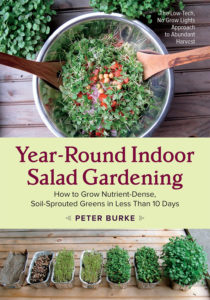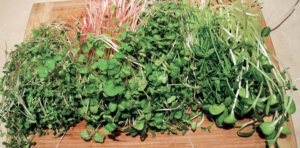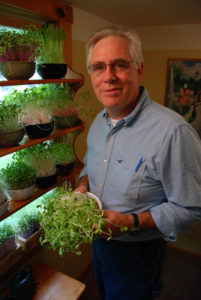A Simple Way to Grow Fresh Greens Indoors
(Even in the Winter!)
Editor’s note: This article is based on new book by Peter Burke, called Year-Round Indoor Salad Gardening. I would like to personally note that I ordered this book after listening to Peter Burke on our podcast and am absolutely in awe of his method and plan to start my own indoor soil sprout garden in the next few weeks!
 Just because the temperatures have started to drop doesn’t mean you have to live without fresh greens until next Spring. With author and gardener Peter Burke’s innovative method of growing soil sprouts indoors, you can grow nutrient-dense greens all year long at a fraction of the cost of buying at market.
Just because the temperatures have started to drop doesn’t mean you have to live without fresh greens until next Spring. With author and gardener Peter Burke’s innovative method of growing soil sprouts indoors, you can grow nutrient-dense greens all year long at a fraction of the cost of buying at market.
Burke’s new book, Year-Round Indoor Salad Gardening, is an inviting guide for both first-time and experienced gardeners in rural and urban environments. No matter what size home you live in, there’s room for a garden of soil-grown sprouts. In fact, Burke has grown up to six pounds of greens per day using just the windowsills in his kitchen. And, since they grow so quickly—less than 10 days from seed to salad—soil sprouts can be an engaging indoor project for kids.
In his book, Burke provides detailed step-by-step instructions to master this simple method of growing greens. The only tricky part is understanding how different growing soil sprouts is from standard outdoor gardening. One of the first steps is placing your tray of seeds and dirt in a dark cupboard, not a typical place for your average plant. In the excerpt below from Year-Round Indoor Salad Gardening you’ll learn all the ways growing soil sprouts runs counterintuitive to gardening and how these tricks not only make sense, but really work!
6 Reasons Why Growing Soil Sprouts is Counterintuitive to Gardening
By Peter Burke

Growing soil sprouts runs counter to much of what I always held true about gardening in general. When I try to explain soil sprouts to my farming friends and gardening buddies, they often have trouble understanding the concept at first. I know what bothers them: They think that if they plant 70 sunflower seeds or 150 broccoli seeds, their crop will be enormous compared to the tray of greens I describe.
One farmer complained, “It is so seed intensive.” He thought too many seeds were required, and he dismissed the idea. He reasoned that one mature sunflower could produce easily hundreds of seeds, or each full-grown plant a large head of broccoli. Why harvest the sprouts before they’ve had a chance to produce their full yield?
But when you look at it in a different light, it makes sense. No one would call it “seed intensive” to grind up wheat berries or corn kernels— which are viable seeds—to make bread or object to boiling rice to make dinner. Soil sprouts are just another way—a different way—to eat seeds. Rather than grinding or boiling I grow them for a short time. Plus many of the seed varieties that I grow for greens wouldn’t be used as food themselves, like radish seeds and broccoli seeds. With my methods, seeds that could only be planted in the outdoor garden in the past can now be used to grow fresh greens indoors. They’ve found a useful place in the pantry as winter food. An indoor salad garden can even work as a full-time garden for those who live in apartments or condominiums with no other place to grow their own food.

Indoor Gardening Takes a Different Approach
The techniques that work for an indoor salad garden of soil sprouts are not the same as those I use for my earth garden. Much of what I had learned about gardening went out the window when I started this project. An indoor garden required an entirely different approach.
For instance, instead of watering the seeds after planting, as I would normally do in my earth garden, I water the seeds before planting by soaking them. Where I usually plant seeds in the soil outdoors, for soil sprouts I scatter the seeds on top of the soil indoors. In my outdoor garden seeds are planted in carefully spaced patterns. For my indoor garden’s soil sprouts I spread the soaked seeds on top of the soil so close together that the seeds touch.
Normally gardeners take pains to provide plenty of light for young plant starts, providing grow lights from the moment the new plants emerge from the soil. It’s a totally opposite approach for soil sprouts; I start them in the dark for 4 days.
For the experienced gardener, it’s a bit of a challenge to go against the grain of years of gardening outdoors. I know it was for me. If this is your first garden and it’s all new, you don’t have the “this-is-how-I-usually- do-it” attitude to overcome. But I should give you fair warning that if your expert gardener friends tell you you’re doing it all wrong, they would be right—that is, if you were growing outdoors!
Just be patient and invite them over for a fresh salad sometime in January, when they’re frozen out of their own gardens.
1. Watering the Seeds First
Presoaking gives the seeds a jumpstart before planting. Usually seeds must soak up enough water from the soil to initiate growth. Depending on the environment it might take days before the seeds even begin to sprout. Although soaking is common to hasten the process of growth for large seeds, with soil sprouts all of the seeds are soaked first, regardless of size. This step is a key to realizing the “fast growth” found in indoor salad gardening.
2. Plant on Top of the Soil
Planting the seed on top of the soil also saves a day or two because the stem and leaf don’t have to push up through the soil. It also prevents the seed hull and leaves from being covered in soil and keeps the sprout cleaner. Cleaner stems and leaves mean there’s less of a chance the plants will develop damp off (a disease that quickly kills young shoots) or molds, and the greens are easy to clean at harvest time. If you’ve ever cleaned fresh greens from the garden, you’ll appreciate this aspect of soil sprouts.
3. Seeds Are Touching
Outside I would need a 50-foot garden row to plant the same tablespoon of sunflower seeds that I use inside in a small tray that’s only 1⁄8 of 1 square foot in size. By planting the seeds so close that they touch, I get the maximum possible harvest of greens from the smallest possible area. The seed has only enough room to send a root down into the soil and a stem up toward the light, but this is entirely adequate for the short “growing season” of shoots.
4. Grow in the Dark
Growing in the dark also flies in the face of everything I know about vegetable gardening. For my traditional garden I use lights and a cold frame or a greenhouse to give young plants plenty of light in the early stages. But soil sprouts are grown for the stem and first leaves of the plant only, and the first few days of darkness encourage a long stem to grow by “forcing” the seed to search for light.
Outdoors, in more hostile conditions, a seed stem may have to make its way through a pile of leaves or straw before it comes out of the dark. The simulated darkness of a tray with paper covers takes advantage of this natural urge in plants to search for light. It encourages a very productive harvest. Total darkness isn’t necessary; even low-light conditions will do the job of forcing the sprouting seeds to develop long stems in the first stages of growth.
5. Plant Every Day
In my outdoor earth garden I typically plant varieties like tomatoes or squash once per season. For vegetables like lettuce and carrots I do a second planting at mid-season to harvest a fall crop. For varieties like radishes I replant every 2 weeks and enjoy a steady supply of fresh roots all growing season.
With soil sprouts I plant every day. For a steady supply of greens from my indoor salad garden, planting every day is key. I routinely start small batches of seeds, about 5 tablespoons (74 ml) spread over five trays each day. So every day a batch of seeds planted a week ago are coming to harvest. And I know just how many trays I’ll need, week to week, harvesting just what I need each time. I want my indoor salad garden to remain small and manageable, not large or time-consuming.
6. Harvest More from the Seed
As I explained above my objective when growing sprouts in soil is to encourage rapid growth of the stem and a large seed leaf (called a cotyledon). This allows me to harvest nearly all of the stored nutrition from the seed. This general principle has been understood in Asia and elsewhere for many centuries. I was surprised to read an Italian recipe from the year AD 1624 that included radish sprouts, and the English have used cress sprouts for many years, too. Rich in vitamin C, cress sprouts helped sailors to combat scurvy on long voyages. For my indoor salad garden, I’ve included a variety of seeds and developed in-depth techniques to grow soil sprouts full time.

This article is adapted from Peter Burke’s Year-Round Indoor Salad Gardening (September 2015) and is printed with permission from Chelsea Green Publishing.
*Disclosure:
Some of the links in our podcast show notes and blog posts are affiliate links and if you go through them to make a purchase, we will earn a nominal commission at no cost to you. We offer links to items recommended by our podcast guests and guest writers as a service to our audience and these items are not selected because of the commission we receive from your purchases. We know the decision is yours, and whether you decide to buy something is completely up to you.







